Located on the eastern coast of Vancouver Island, Nanimo is a city that is often overlooked by tourists. Its legacy is often regarded little beyond its historical waterfront and – of course – Nanaimo bars. Beyond the waterfront and the (seemingly endless) sprawling suburban expanse however, Nanaimo’s landscape unfolds into a mix of rolling hills, dense forests, and a network of lakes, providing a rich backdrop for outdoor activities. The landscape here might not be as dramatic as some of the more mountainous regions of Vancouver Island, but many of the views are nonetheless incredibly beautiful.
Much of the forests and mountains southwest of Nanaimo (including its watershed!) are privately owned by logging companies which restrict public access. As a result, much of Nanaimo’s potential as an outdoor recreation destination has been limited. Forested lands close to the city are bulldozed for more suburbs, and the forests further away locked behind gates and turned into a patchwork of cutblocks. Nanaimo hiking enthusiasts might not be spoiled for choice, but the Nanaimo hikes that are available? They’re excellent.
Continue reading this blog post for everything you need to know to experience these awesome Nanaimo hikes for yourself, including distance, elevation gain, how to get there, the best time to visit, and lots of photos of my experience.
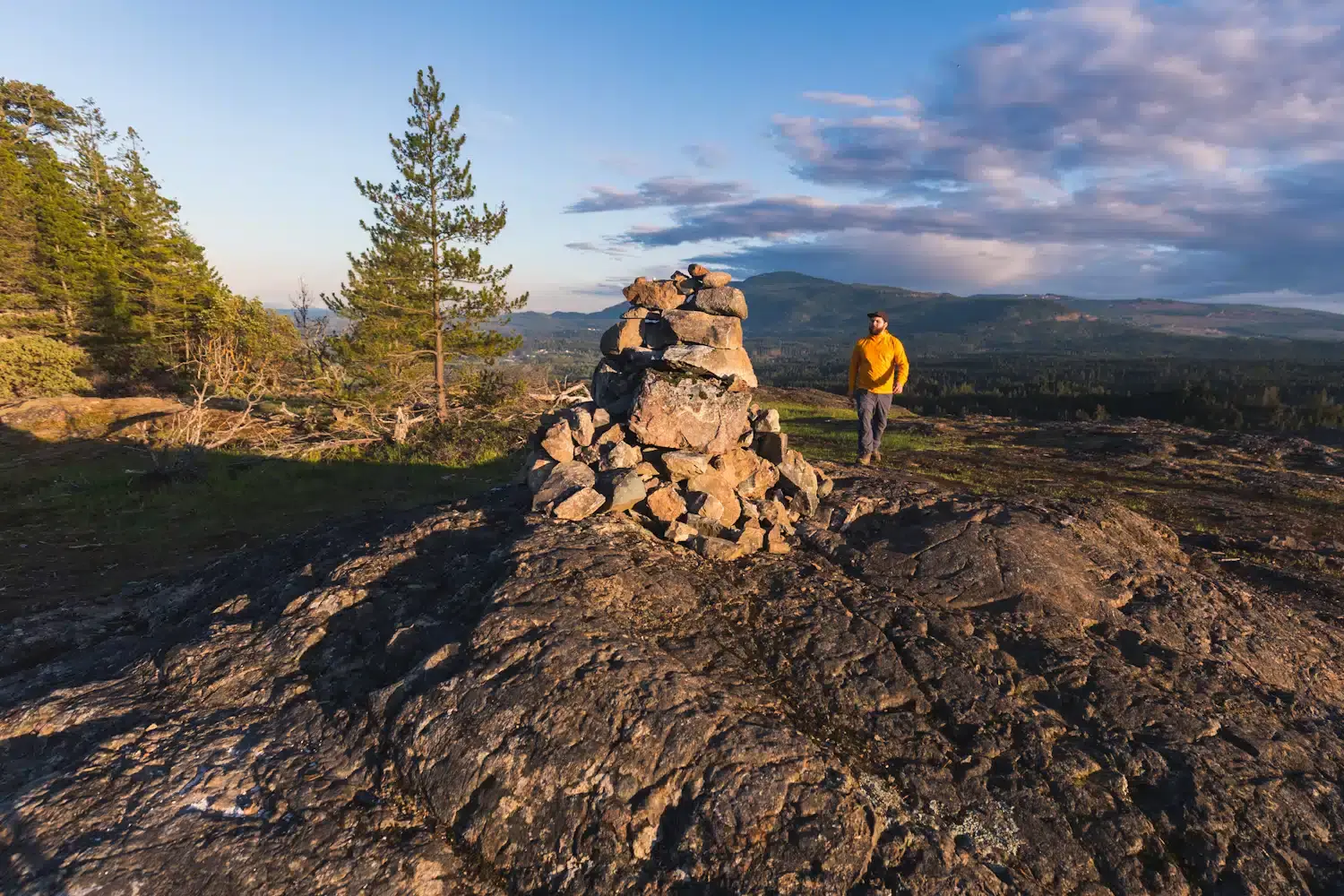
When in the outdoors it’s important to avoid harmful practices such as disturbing plants or rock-stacking, or removing any natural object from flowers to rocks, as it’s important to leave the environment as natural as possible for the animals and for fellow hikers to enjoy in perpetuity. As many flowers as there are, there are few enough that if we all took one, then there wouldn’t be any left. Take only photos, leave only footprints.
I also highly recommend reading up on Leave No Trace principles before heading anywhere into the outdoors in general. Following these important principles basically means doing your best to leave beautiful places like these Nanaimo hikes as good (if not better) than you found them, both for their preservation and for the enjoyment of other visitors.
Waterfall Hikes Near Nanaimo
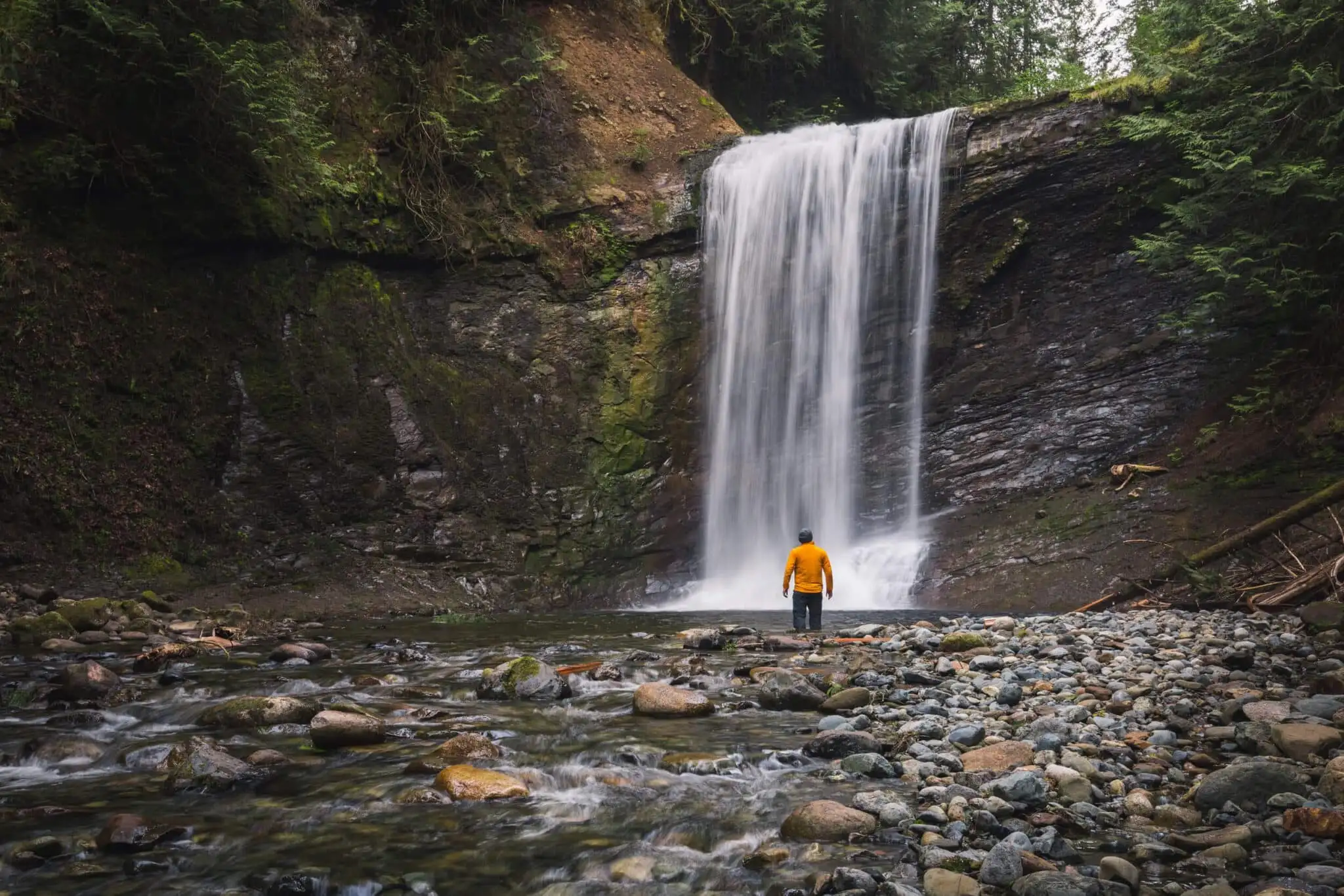
One of my favourite things about Vancouver Island is the seemingly endless amount of incredible waterfalls, often located within the most beautiful of surroundings. If you plan on heading out chasing waterfalls, Nanaimo is the perfect place to start. I can’t think of anywhere on the island that has so many easily accessible waterfalls right nearby. In fact, five of these picturesque waterfalls are located right within the city itself! Of the others, none is more than a half hour drive away. While some of these waterfalls take slightly more effort to reach than others, the difficulty level ranges from nothing more than a short walk to an easy hike (with one exception of a steep downhill with some short bushwhacking). Like all Vancouver Island waterfalls, the best time to visit us winter and spring. After rain these waterfalls are at their most powerful, but if visiting during drier parts of the year some of them dry up considerably.

Lonetree Hill

Distance: 4.2 km / 2.6 mi
Elevation Gain: 188 m / 617 ft
Hiking Time: 1.5-2 hrs
Lonetree Hill, not to be confused with nearby Victoria’s Lone Tree Hill, is a fantastic high point northwest of Nanaimo that offers exquisite panoramic views north over the Straight of Georgia and south over Vancouver Island, including a stunning view of Mt Benson as it looms over Nanaimo. This fantastic Nanaimo hike is easily doable in under two hours, and the views are amazing. That said, as Nanaimo’s steadily spreading suburban hellscape of cul-de-sacs encroaches on this beautiful area, once can’t expect the views to be as pristine for long. So I suggest getting out there and enjoying the hike up Lonetree Hill while you can!
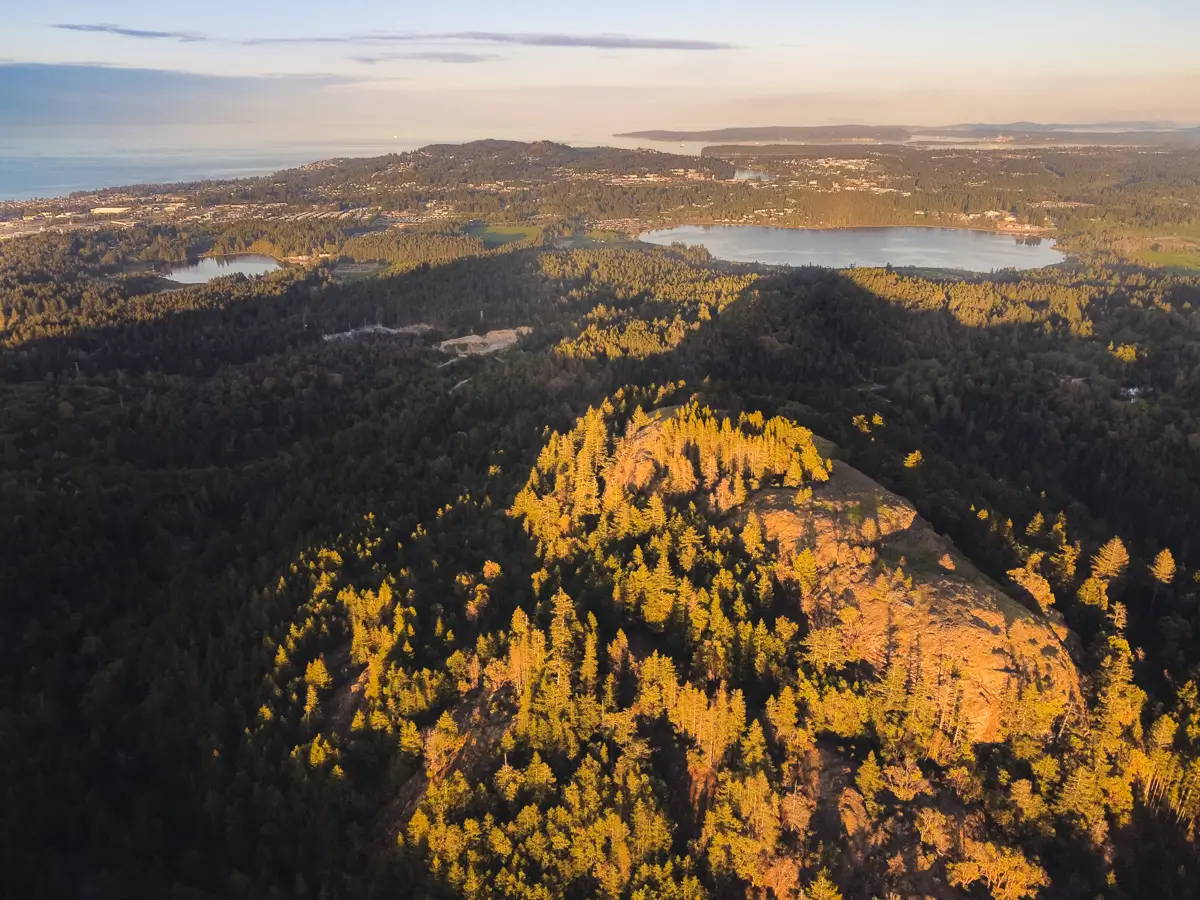
Little Mountain
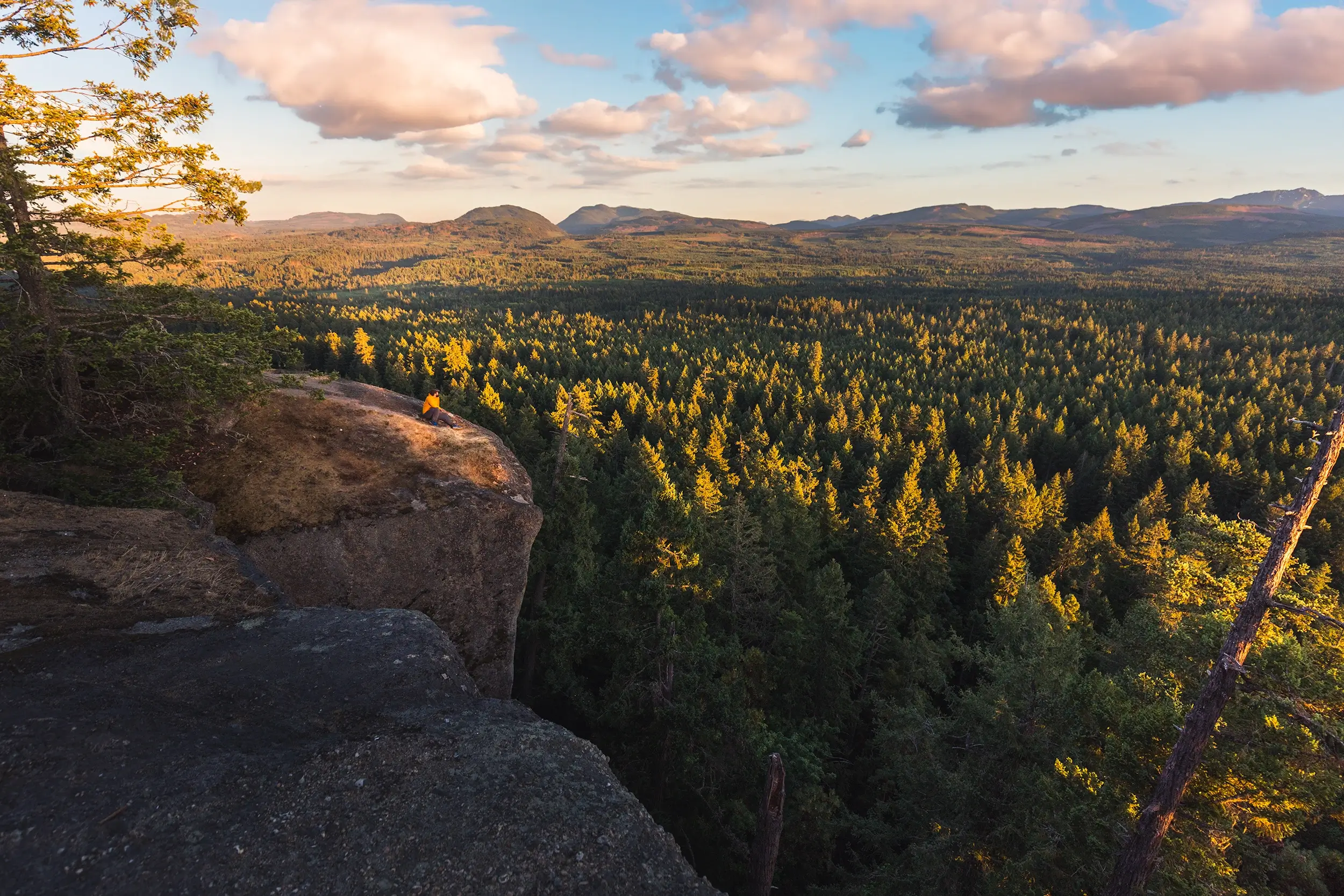
Distance: 5.6 km / 3.5 mi
Elevation Gain: 167 m / 515 ft
Hiking Time: 2 hrs
If you’ve taken a drive north from Nanaimo, somewhere around Parksville you’ve probably looked left out your window towards the distant Mt Arrowsmith and the Beaufort Mountains stretching north, separating the Alberni Valley from Vancouver Island’s east coast. You may have also noticed a much closer, much smaller bump not far from the highway – I wouldn’t blame you if you can’t remember seeing Little Mountain – compared to the much more majestic distant mountain peaks it doesn’t look particularly memorable. The views from the top of this Vancouver Island hill, once the site of a forestry lookout, are another story.
Hikers near the top of Little Mountain are greeted with sweeping views including Nanaimo’s iconic Mt Benson to the south, Mt Moriarty, Mt Arrowsmith, Mt Wesley, and the many peaks of the Beaufort Range. In the distance Denman and Hornby Islands are visible to the north, with a tiny blue ribbon of sea separating them from Vancouver Island. The wide-open western views from Little Mountain make it a perfect sunset location, and the road winding up to the top of the hill means it’s popular among non-hikers as well. Sadly this has been to the site’s detriment, as it’s a popular dumping ground. Local hicks drive up furniture, appliances, and all sorts of garbage and toss it off the cliffs onto the trail below for fun. Looking down from the top of the cliffs is a horrible view of a garbage dump. Fortunately the trail directly below the cliffs is not the trail I took to hike up Little Mountain.
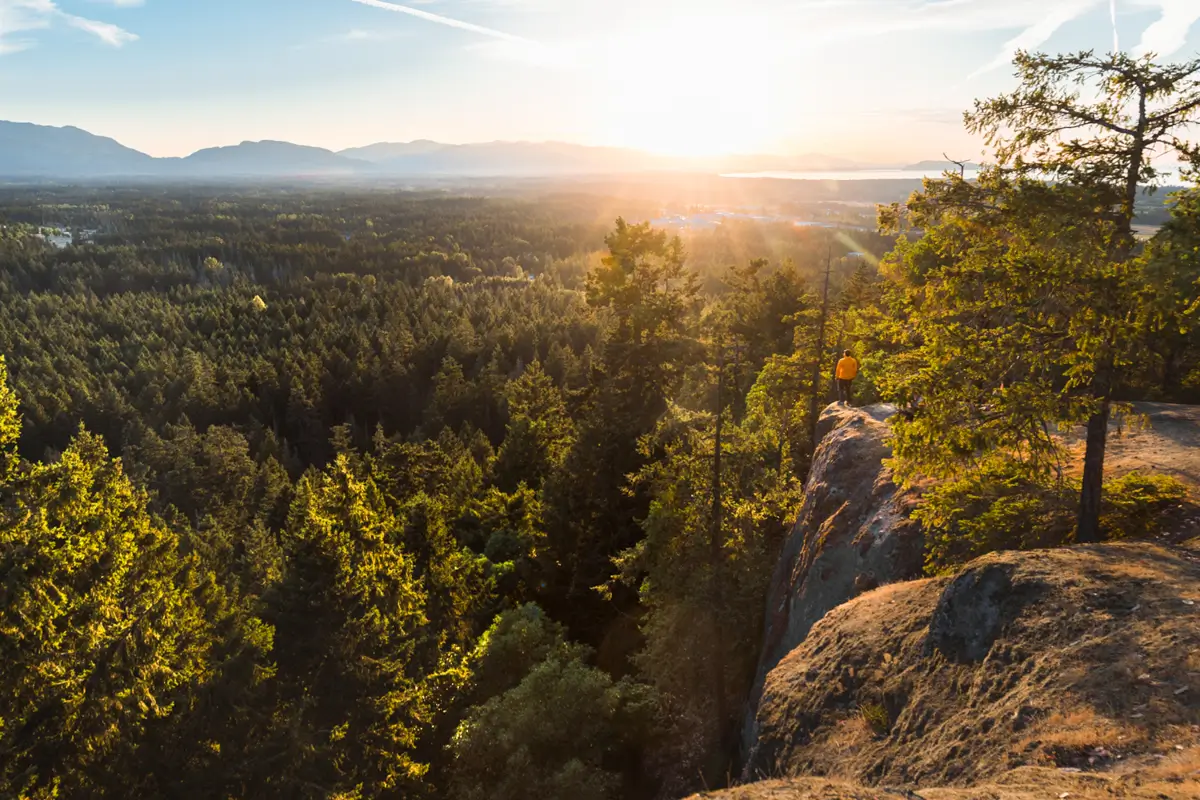
Mt Benson
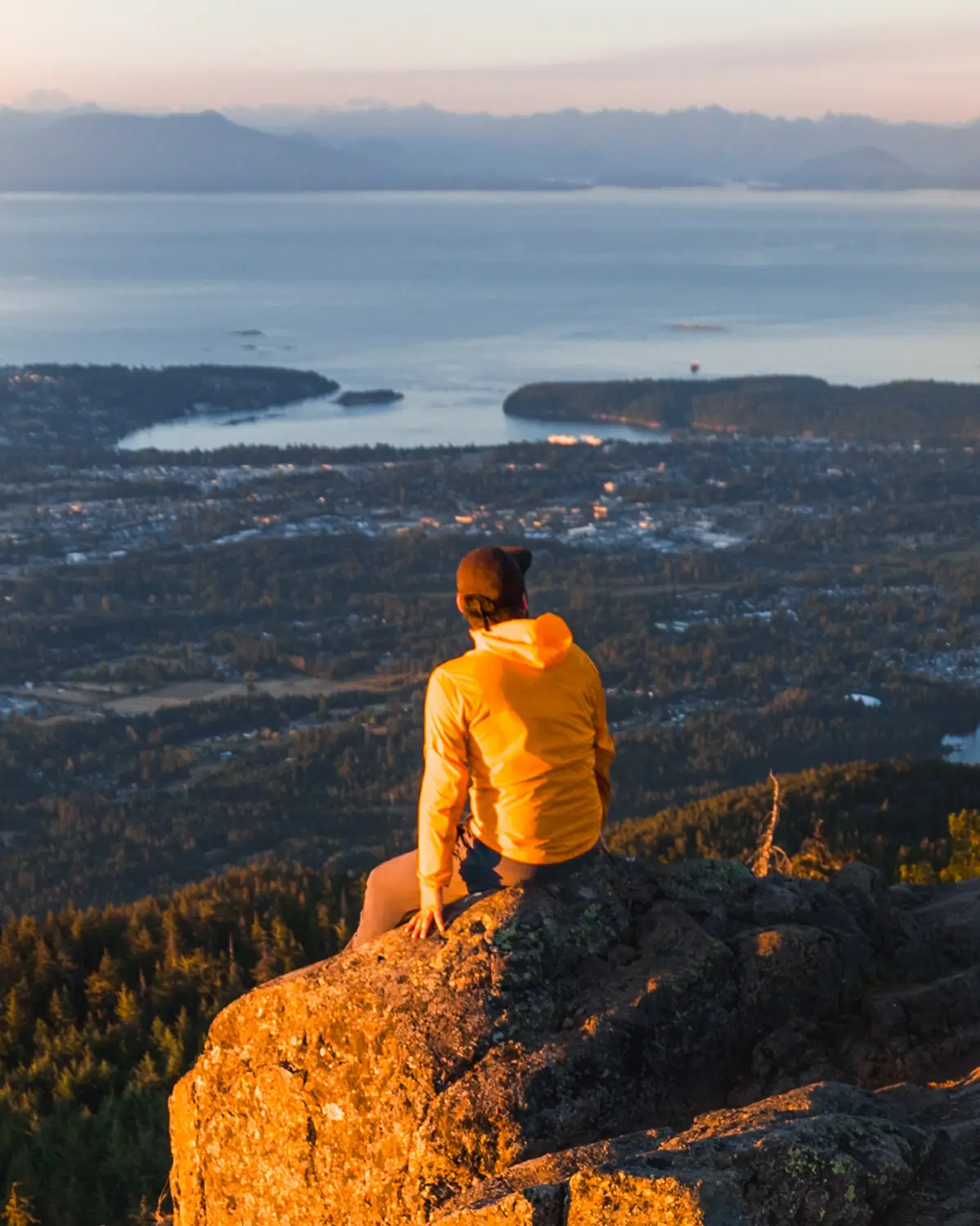
Distance: 7.6 km / 4.7 mi
Elevation Gain: 874 m / 2867 ft
Hiking Time: 3-4 hrs
A prominent landmark off Southern Vancouver Island, Mt Benson dominates Nanaimo’s skyline. This iconic peak has far-reaching panoramic views that entirely justify the slog up to the top, making it the best hike to do near Nanaimo for a spectacular sunrise or sunset. From Mt Benson’s summit hikers can clearly make out Vancouver’s shining skyline way across the Salish Sea, with a backdrop of snowy mountains stretching all the way across the horizon. Other more local landmarks include impressive Mt Arrowsmith to the northwest, and numerous named and unnamed peaks to the south. It’s no wonder this peak was once the site of a fire lookout.
The hike up Mt Benson is a pretty unrelenting uphill grind, with several sections steep enough to warrant the installation of helpful ropes. Of particular note is the final 50 meters or so breaking up out of the woods to the summit, which is basically mild rope-assisted scrambling. expect to use your hands a little here as you ascend the staircase-like blocky stone mountainside. The trail up Mt Benson never feels unsafe though, and should be conquerable by any fit hikers.
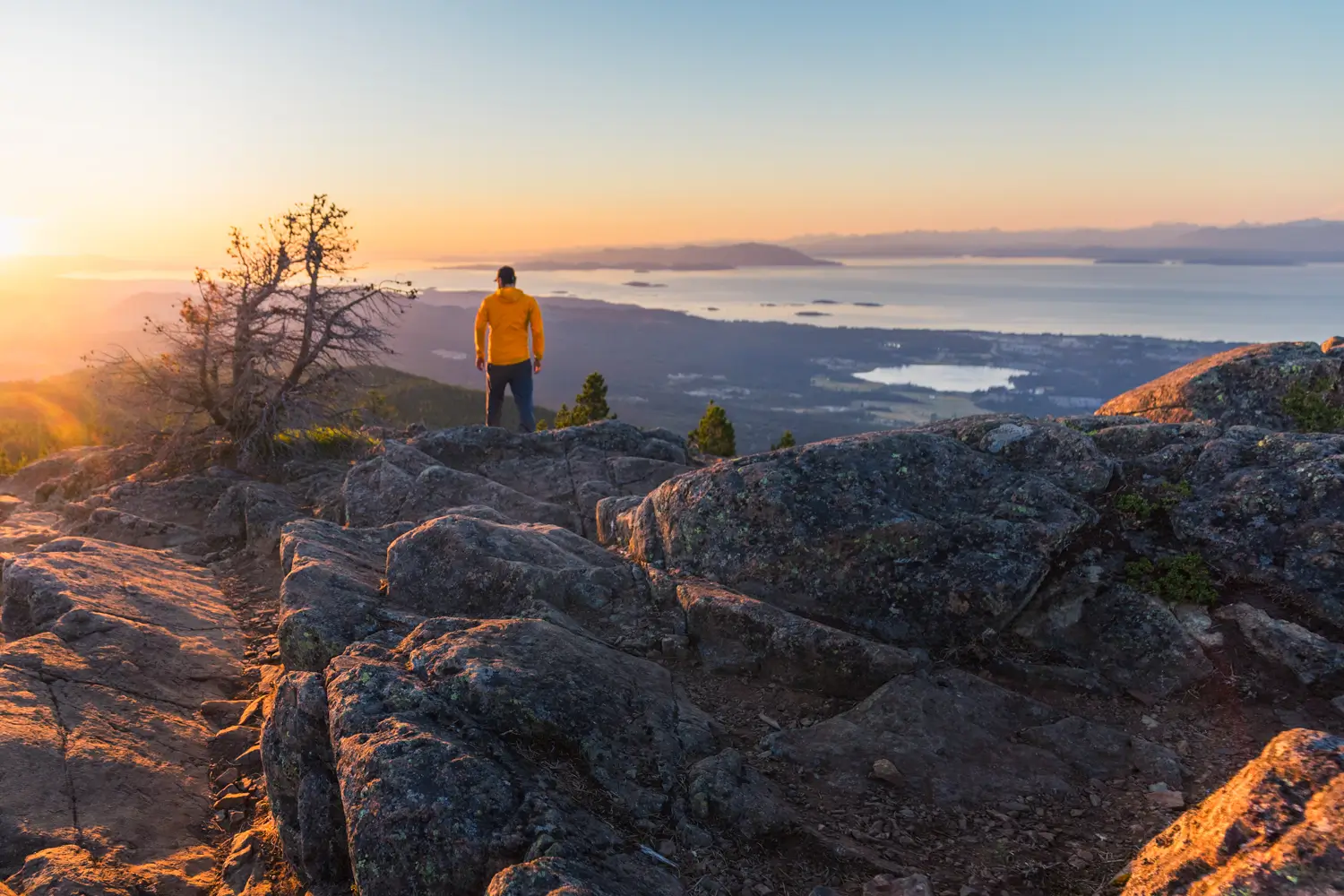
Recommended Hiking Gear



Water is a must whenever I’m hiking, especially if the sun is going to be out. My favourite water filter I’ve used is the Katadyn BeFree 0.6L, which unlike other water filters I’ve used packs up really small and lightweight. For hikes where I know there won’t be any readily available water sources along the way, I make sure to bring my own. The Hydrapak Stow 1L bottle is my go-to, for the same reason that it’s made of a soft plastic that folds up and doesn’t take up any more extra space than necessary in my pack. Finally, Aquatabs are another great option for purifying water, with one tablet being suitable for one litre of water. I previously used the Grayl water filter while travelling internationally, and though I found its hard body more convenient for day to day use and easier to drink from, it has a little too much bulk for my fast-and-light style of hiking.



The secret to all my photos of gorgeous sunset and sunrise mountaintop views? A lot of hiking in the dark. And let me speak from personal experience when I say that the last thing that you want to happen when hiking is to be caught in the dark without a headlamp. I used the Black Diamond Spot 400 for years and it worked great – until I lost it on top of a mountain somewhere. The only downside to it was having to worry about the batteries dying, though there’s also a slightly more expensive version that has a rechargeable battery. Nowadays I’m using the Petzl Actik Core, which is a bit pricier than the more budget-friendly Black Diamond, but is also brighter, more comfortable (in my opinion), and has a hybrid power system that is rechargeable but can also take AAA batteries if needed.
You won’t see me using trekking poles on shorter hikes often – but on long hikes and backpacking trips, as well as certain scrambles, they are an absolute lifesaver. I’ve invested in a high quality ultra-lightweight pair of MSR DynaLock Ascent carbon poles which, while pricey, I don’t regret one bit. If you’re not entirely sure how much use you’re going to get out of a pair of trekking poles, the best budget-friendly option would be the Trekology Trek Z 2.0. Amazon does sell a lot of cheaper Made in China-style trekking poles for cheaper, but these usually are much much heavier and not worth buying.
All the best and most long-lasting cables and power banks I’ve ever owned have been Anker. I once had a phone cable from them that lasted me over three years of daily use! That’s why I keep an Anker PowerCore Essential 20K power bank on me. Like many people I use my phone for a lot of stuff when hiking (checking in with family, using online maps, taking photos, flying my drone) so I like to be prepared for that low battery warning by having a backup power source on me just in case.



The only socks I ever buy for myself are from Darn Tough, and I almost always make sure to wear them when hiking. After years of having no problems only wearing these comfortable and rugged socks for hikes, I accidentally wore a pair of no-name socks on a hike last year and ended up with blisters on both feet. Safe to say I’m back to sticking with the Darn Tough. And the best part? They have a lifetime guarantee, meaning that if they ever wear out you can send them back for a brand new pair. For hiking footwear I go between a pair of lightweight approach shoes for quick and dirty mountain ascents or anything involving scrambling and more heavy-duty boots for longer treks. I’ve worn a couple different versions of the lightweight but super durable Arc’teryx Konseal FL 2 approach shoes for a few years now and am very impressed with the durability. I also really like the thick toecap that keeps me protected every time I stumble into a root or large rock. For longer, tougher, or muddier treks I rely on my LOWA Camino EVO GTX, which I find insanely comfortable and made of very high quality.



I wear my Ar’teryx Gamma Lightweight Pants on every single hike I go on, and on many days when I’m not hiking. After several years of abuse they are still holding together extraordinarily well, with only a few small holes from where I’ve fallen down and some slight stains from being repeatedly coated with mud. They’re lightweight, breathable, and super comfortable. For lightweight and breathable hiking tops I’m a big fan of both the Patagonia Capilene Shirt and the MEC Core Shirt. My Arc’teryx Squamish Hoody shows up in a lot of my photos. It’s super lightweight and packable, and does a great job of cutting the wind while also being pretty breathable. I also have an Arc’teryx Atom Hoody and Arc’teryx Beta LT that I pull out for cooler or wetter conditions.
